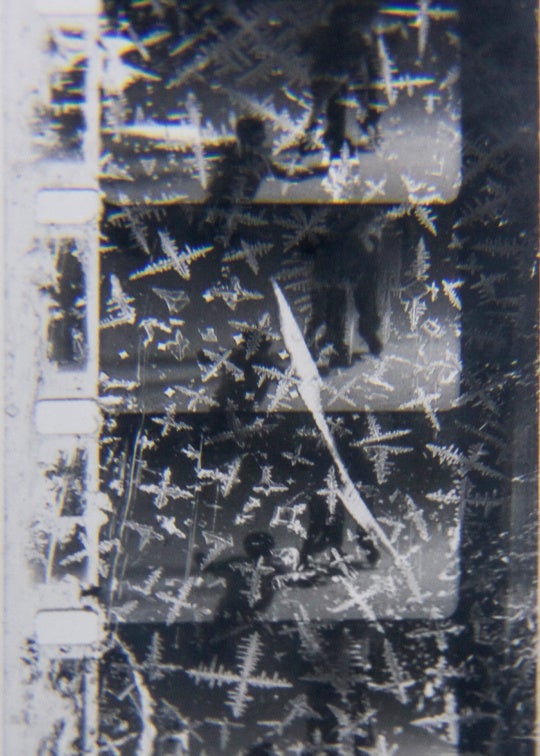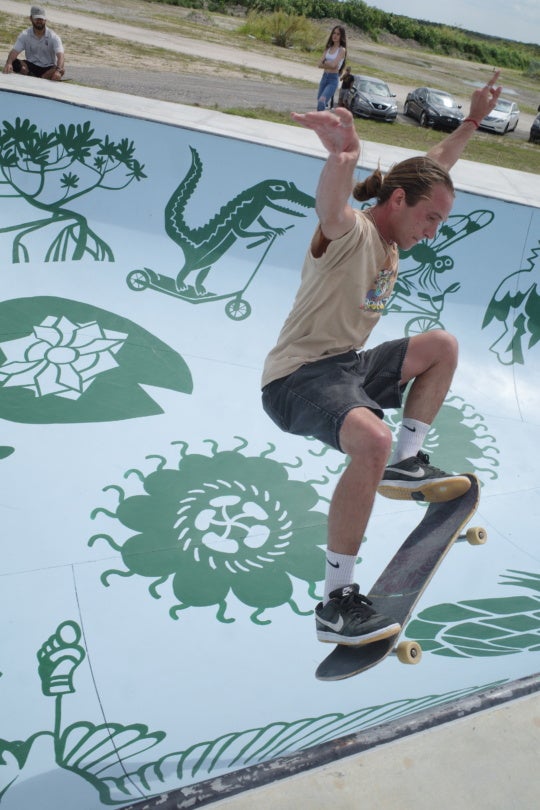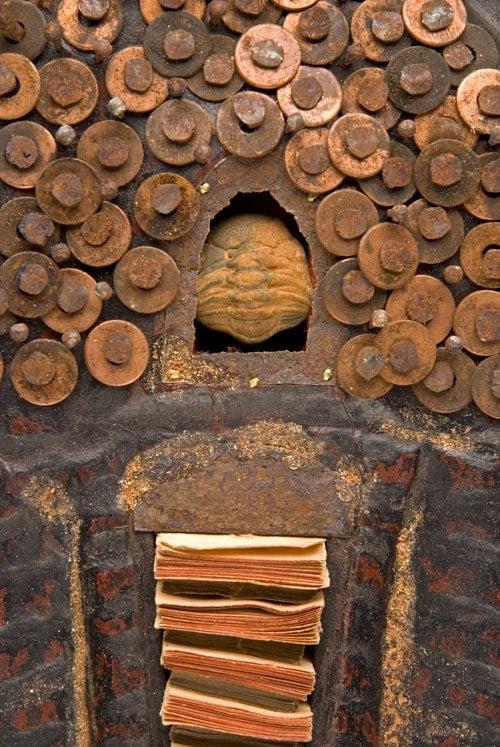“One is too few, but two are too many.” —Donna Haraway
In 2003, the global market for contemporary art went nuts. Auction prices for artists born after 1940 jumped twenty-two percent from the year before on the strength of works by Basquiat, Takashi Murakami, Jeff Koons, and their ilk. You could almost hear the corks popping in the night sky all over the upper east side of Manhattan.
Two other things happened that year: The United States led an invasion of Iraq in search of nonexistent weapons of mass destruction, causing a different kind of popping in the night sky. And Kenyan-born artist Wangechi Mutu, just three years out of a Yale MFA sculpture program, made her debut solo exhibition with horrific, sensuous collages at Susanne Vielmetter Los Angeles Projects. David Pagel called that debut “among the best in recent memory” in the LA Times. Ms. Mutu had arrived in the contemporary art world like a bomb over Baghdad. In A Fantastic Journey, her current survey at the Nasher Museum of Art at Duke University, the artist presents 10 years of aftershocks to the cultural earthquakes she emerged out of [March 21-July 21, 2013].
Wangechi Mutu’s career gained momentum in parallel with the hypersonic growth of the art market. But by 2006, what started out looking like enthusiasm for contemporary art was beginning to look more like speculative greed. Hammer prices for the bratty enfants terribles of art—Cattelan, Basquiat, Koons, and Hirst—seemed overblown even then.
That same year, Mutu created an installation (not in the current exhibition) for New York’s Salon 94 against the background of art market greed and the war in Iraq. That installation, titled Exhuming Gluttony: A Lover’s Requiem and undertaken in collaboration with British architect David Adjaye, featured an absurdly sumptuous, wine-stained banquet table; hanging, inverted wine bottles; bullet-riddled walls; and a ludicrous fur wall sculpture facing the head of the table. The work yoked unsustainable avarice to unnamable systems of violence in an orgy of luxurious sense stimulation.
The themes of consumption and the aftermath of violence used in Exhuming Gluttony reappear again and again in A Fantastic Journey. So does the visual sensory overload that is the calling card of the 16 large-scale collages, the handful of smaller works on paper, a number of sketchbook pages, and five videos and site-specific installations.
One Hundred Lavish Months of Bushwhack (2004) is an exemplary work. On loan from the MoMA collection, the life-size collage depicts one of Mutu’s signature female chimeras: a woman-creature with dappled skin that suggests fungal disease, the stains of bodily fluids, or clouds as seen in a hallucinatory daydream. Her skirt is a riot of serpentine tendrils that might read as raffia except that they seem to be alive like the writhing limbs of a monstrous sea anemone, undulating in an undersea current. She stands toppling over one foot, a mess of exploding, bloody motorcycle parts. The other foot—in a black, spiked high heel—is held aloft by a smaller, darker creature that stares out from the picture, imperious and solemn. The hands of the larger figure are the mouths of hippopotami, and a mass of red splatter marks testifies to some other ferocious injury to the head caught midway.
Other works add to the visual too-muchness with plastic pearls, mica flakes, sequins, fake wood contact paper, and other items. Funkalicious fruit field (2007), a rare landscape picture, is one such work. Humming (2010), a nightmarish amalgam of menacing insects, monstrous wildflowers, and distorted, hypersexualized female bodies is another.
“If you want to know what an animal’s system is about,” Mutu has said in an interview, “you look at its shit. . . . You sift through its stool.” With the same scatological process, Mutu sifts through the shit of the newsstand—ethnographic magazines, muscle car rags, fashion, and porn—to diagnose a global diet of excess, violence, and the battlefield of women’s bodies.
**********
Mutu’s collages and videos are as beautiful as they are unsettling. The tactile quality of the luxurious painted passages and the scintillating, high-contrast surfaces make the work feel sculptural, the colors almost edible. Most of the large-scale works are made on Mylar, a semi-transparent material that creates subtle shadows behind the surface forms, lending a tangible meatiness to the images.
Mutu continues down a path blazed by Sun Ra’s Space Is the Place, as well as by painters like David Huffman and Chris Ofili who imagined black bodies populating alternative landscapes and outer space fantasies. Cauleen Smith and Julie Dash, both filmmakers, and science fiction writer Octavia Butler also are forerunners. Dada collage artist Hannah Höch’s influence appears as well, particularly in the 13 smaller works on paper (all 2012). Imagined as a mythical family of deities, the portraits in Family Tree take a freer, more surreal approach to the human form.
Mutu adds a specific concern with African women to this mix. A 1991 stampede and mass rape of 71 female students in a Kenyan dormitory and the disfiguring violence of the Sierra Leone “blood diamond” trade and its effects on women in war zones both shed light on dramatic gender inequality across Africa.
Mutu’s surprising early response to these atrocities was the 2001 Pin-Up series (not in the current exhibition). The small paintings with collage elements depict women in bathing suits or topless, many with missing limbs supplemented by crutches or propping devices. But rather than overtly condemning violence, the images are sexy and perversely joyful. They’re not lamentations of war; they’re totems of survival.
A few of the works in A Fantastic Journey feature similarly injured or truncated body parts. But even when they don’t, Mutu’s characters are always partial, wounded, and held together only by metaphorical stitches and rivets.
The regal portrait in Pretty Double-Head (2010), for example, is cobbled together from animal bodies, ethnographic artifacts, more motorcycle parts, and importantly the bodies of other curvaceous, mostly brown-skinned ladies harvested for spare parts under the artist’s blade. Although beautiful, Pretty Double-Head is built on a structure of chaotic dovetails and paint resembling bloodstains. A story that ends in sublime beauty begins with an allegory of pain.
Other amalgamated bodies are completed with wheels as in the distended horse-like body of the central figure in Once upon a time she said, I’m not afraid and her enemies became afraid of her The End (2013), a site-specific installation situated in the front entry way. Or, composed with animal hides and bling as in The Root of All Eves (2010). And everywhere, the figures’ legs terminate in feet made of concatenated motorcycles, hinting of speed, danger, and sexy machines.
To borrow Donna Haraway’s famous phrase, Wangechi Mutu would rather be a cyborg than a goddess. Her characters are uninterested in achieving the state of innocence they must have had before their horrible, violent suffering. They’re not interested in a backward glance toward Eden. Instead they look forward to the prosthetic for living that is the cyborg future, thriving on the polluted, improvisational identities that destroy the line between human and animal, between technology and biology.
The cyborgs are in charge now. Their bodies, fashioned from scraps of an older world, also imply a new morality. Indeed, what may be most compelling about Mutu’s work is just how profoundly unmoralistic (in the old-fashioned sense) it really is. Unlike the cognitive double-takes that Martha Rosler or Candice Brietz demand, these collage-paintings don’t want to raise your awareness or make you take responsibility for a bad world. They don’t seem to care all that much whether you become a better person or not. They simply celebrate living ecstatically in the face of destruction. In Mutu’s world, survival isn’t just what’s left over when war doesn’t kill you; survival is a form of erotic pleasure.
**********
Visual pleasure took a hit in the 1970s. Film theorist Laura Mulvey’s “Visual Pleasure and Narrative Cinema” declared war on traditional screen images of women as passive and inert. The phrase “the male gaze” entered the academic lexicon and quickly became a bludgeon aimed at images of women whose sexual presence was deemed too available for men to look at, too obviously there. For two decades, not only did female bodies become taboo among a certain cognoscenti, but narrative film, the medium of painting, and the idea of beauty in general all got caught up in the same raid on traditional western pictorialism.
A generation later, those cultural prohibitions have begun to look needlessly puritanical. Female artists (and a few male ones—think Matthew Barney or Tomas Esson) pursue options hardly imaginable to artists when Mulvey’s article was published in 1975. Today, nude female bodies, cascading hair, and parted lips no longer automatically imply a metaphorical rape. And such images aren’t just for an audience of “drooling average Americans,” as Lane Relyea snobbishly alleged in his 1994 Artforum takedown of Lisa Yuskavage’s buxom nymphets.
No one exemplifies the new possibilities more lustily than perhaps Mutu’s fellow traveler Marilyn Minter—whose large-scale photographs and paintings of females effecting unabashed sexual postures in decadent settings spring from some of the same cultural soil as Mutu’s. Minter has even produced a set of works featuring Mutu as a model.
Mutu joins Minter, as well as Mickalene Thomas, Rita Ackermann, Cecily Brown, and other image makers who navigate a third way between the dick-thrusting machismo of traditional images and the castrating prudishness of second-wave feminism. Exploring the power dynamics of femininity needn’t mean a tradeoff between political strength and the fleshy embodiment of lived experience. Pleasure has come back, this time with teeth.
It’s an attractive compromise, one that may help explain what looks like a growing influence on a generation of artists emerging in Mutu’s wake. Formally Ebony G. Patterson, Kenyatta A.C. Hinkle, and Whitney Wood Bailey, for example, all seem aware of Mutu’s work. And without the aesthetic space cleared by Mutu and her cohort, a Shana Robbins would not be possible.
**********
The didactic texts throughout the Nasher galleries attempt to corral the meanings of several works. They are, viewers are told, allegories of the colonizing of Africa or an invective against hierarchies. Such explanations may justify how the images got there, but they leave out the much more radical story of what they’re doing once there. The magnificent ecstasy of the surfaces, the orgasmic pleasure of Mutu’s impossible fashion-spread bodies, pack a far more radical wallop than a bland memo that, in case you didn’t know, war is bad.
More urgent are the methods of survival Wangechi Mutu points to: the cyborg ethos of recombinant identities, exquisite pollution, and compulsory cross-pollination that are the hallmarks of an age to come. A Fantastic Journey previews the science fictional bodies we may already inhabit. Those bodies know what is erotic about survival. They get off on a bionic future.
The goddess is dead. Make way for the cyborg.
Wangechi Mutu: A Fantastic Journey
Nasher Museum of Art at Duke University
March 21‑July 21, 2013




